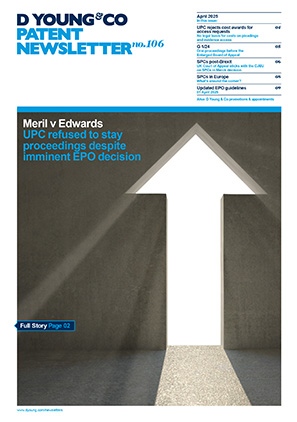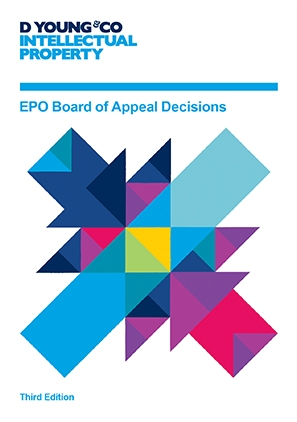CNIPA and EPO: Examination trends for business method related inventions
In our previous article “Computer implemented inventions (CII) in CNIPA and the EPO - recent developments of examination practice”, we briefly discussed the China National Intellectual Property Administration’s (CNIPA’s) approaches of examining CII patent applications under the proposed amendments to the China Patent Examination Guidelines and compared them to the practice adopted by the EPO. This article follows up on the topic and looks into the examination standard specifically for business method related inventions, which are also commonly implemented by computer programs, by going through some of the guidance examples and recent decisions issued by the CNIPA Patent Reexamination and Invalidation Department and the EPO Technical Board of Appeal.
Computer implemented inventions in CNIPA and the EPO - recent developments of examination practice
Read moreBackground
Business method patents were once taboo in the patent world since most jurisdictions refused to grant patent protection for innovation in pure business methods. For example, Article 52(2)(c) of the European Patent Convention explicitly excludes the patentability of the subject-matter or activities related to schemes, rules and methods for doing business as such.
In China, although methods of doing business are not written in the exhaustive list of non-patentable subject matters under Article 25(1) of the Chinese Patent Law, pure business methods are traditionally regarded as rules and methods for performing mental acts and hence non-patentable. Even if a patent claim involving business rules also contains technical elements such as hardware features, it might also risk being rejected for failing to solve a problem by utilizing the law of the nature, hence not qualified as a “technical solution” under Chinese Patent Law Article 2(2).
Nevertheless, as information technologies emerged towards the end of the last century, they have spurred innovation in various complementary fields including the commercial and business sectors. Patent offices across the world started to grant patents which relate to business practices. In 2006, the International Patent Classification (IPC) also introduced the main group G06Q for categorizing business method patents, and WIPO describes the group as “data processing systems or methods, specially adapted for administrative, commercial, financial, managerial, supervisory or forecasting purposes; systems or methods specially adapted for administrative, commercial, financial, managerial, supervisory or forecasting purposes, etc”. With tens of thousands of patent applications under this category being filed every year, the EPO and CNIPA have evolved and refined their own patent examination practices, aiming to strike a balance between providing protection, encouraging innovation, and promoting competition.
Recent CNIPA approach
In CNIPA, while the draft Examination Guidelines Amendment previously published for public consultation in August 2021 is still being finalised, the current practice concerning business method patents is prescribed by the Examination Guidelines in force which was issued in December 2019. Among other updates, the 2019 edition contains a whole new section 6 in Part II, Chapter 9 to set out the guidance for examining CII inventions, and covering specifically business method patents.
This includes the assessment of invention step for “new business new field” inventions related to, for example, AI, Internet+, big data and block chain, and characterized by patent claims containing a mixture of technical features and non-technical features. Note that by “non-technical features”, it means those intrinsic features which are not eligible for patent protection, for example, scientific discoveries, mathematical models, method of doing business, etc. Therefore, machine learning models are still considered as “non-technical features” under the patent law since they are mathematical models in nature, even they are viewed as science and technology developments by common understanding.
Leading Patent Reexamination and Invalidation Department invalidation case
Among the top ten patent invalidation cases announced by the CNIPA Patent Reexamination and Invalidation Department in 2021, the “power bank rental method” case was given as a prototypical example for the examination standard of business method applications. The patent in the invalidation case concerns a method, a cloud server and a power bank rental terminal and targets to provide flexible charging services for renting a power bank from a mobile terminal. The rental process involves communication between the mobile terminal, a cloud server and a power bank rental terminal, and is conducted by automatically matching the technical specifications of the mobile terminal and the power banks available at the rental terminal.
The closest prior art discloses a bicycle rental management method based on mobile phone application. The method similarly requires data transmission between three parties: a mobile terminal, a server, and a rental apparatus having a bike lock. The distinguishing features lie in the application scenario. According to the closest prior art, the renting party needs to check the conditions of the bikes available for renting and select a suitable bike based on their preference. On the contrary, the rental process of the patent in dispute is completely controlled by the system consisting of the mobile terminal, the cloud server and the power bank rental terminal. User intervention is not required in selecting the power bank and in particular the renting party does not need to check the power banks in the rental terminal in order to choose the suitable one. On this basis, it was found by the Patent Reexamination and Invalidation Department decision that the above distinguishing features provide the technical effect of user convenience and a more reliable and efficient rental process. Specifically the Patent Reexamination and Invalidation Department ruled that the application scenario of the claimed invention achieves reliable technical effects without excessive user participation. These technical effects are not obtained by the business rules alone, but through an integration of the business rules and the corresponding technical features, so that the respective features are mutually supporting and interacting with each other.
The decision demonstrates the principle that when judging the inventive step of an invention where the distinguishing features are business rules, the role of such business rules should not be ignored by default. Instead, the interaction between the technical features and rule features should be reviewed in order to determine whether the technical solution as a whole can solve a technical problem and bring about a technical effect through mutual support and interaction of the respective features.
Example in CNIPA Examination Guidelines
The decision seems to be consistent with the provisions in the Examination Guidelines and particular the analysis in the hypothetical example of “logistic distribution method” case which emphasized the analysis of “mutually supportive, having an interactive relationship” between non-technical features and technical features.
Specifically, the claimed method distinguishes from the prior art by the step of notifying the arrival of batch orders. The distinguishing feature is realized by introducing new logistic rules as well as modifying the data structure and protocols for the communication between the server, the logistics terminal and the user terminal. Therefore, the logistics rules and the technical implementation are functionally mutually supportive and have an interactive relationship. The claimed invention solves the technical problem of how to increase the efficiency of sending order arrival notification. Furthermore, a technical effect is recognized by CNIPA based on the enhanced user experience which is achieved by faster reception of information about the order arrival status.
Recent EPO approach
The EPO sets out the relevant examination practice in its Examination Guidelines G-VII 3.6, which is also highlighted as the “COMVIK approach” in the 2022 March version. The approach has been affirmed by the Enlarged Board of Appeal decision G 1/09 issued in 2021. The EPO Guidelines additionally provide five case examples to illustrate the COMVIK approach in accessing inventive step of mixed inventions. The first example related to “method of facilitating shopping on a mobile device” may be considered as a benchmark case as it was repeatedly cited to reflect the EPO practice in comparative study reports jointly prepared with the CNIPA and the JPO.
Example in EPO Examination Guidelines
In the “method of facilitating shopping on a mobile device” example, the distinguishing features over the prior art are: (1) allowing user to select two or more products to purchase instead of a single product only; (2) providing the user an “optimal shopping tour” for purchasing the products; and (3) determining the present optimal shopping tour based on previous optimal shopping tours stored in the cache memory.
The EPO Guidelines determines that distinguishing features (1) and (2) are business-related, hence non-technical and making no technical contribution over the prior art. Only distinguishing feature (3) makes a technical contribution and the objective technical problem is how to modify the method of the prior art to efficiently implement the business concept according to features (1) and (2).
The EPO seems to be generally reluctant to recognize any technical effect produced by business rules. In fact, all case examples discussed in the EPO Guidelines have concluded that no technical character is contributed by the business rules concerned.
Technical Board of Appeal appeal cases
Apart from the EPO Guidelines examples, it is observed that the COMVIK approach has been widely adopted in recent Technical Board of Appeal decisions involving mixture of technical and non-technical features:
T 1259/15
The subject-matter of the application relates to a handheld device for determining the location of physical objects stored in storage containers. The closest prior art already discloses that mobile devices could be used to read tags to identify objects and locations though it fails to disclose a logical association of the physical object and the storage container in which the physical object is placed.
In the decision, the Board of Appeal considered that logically associating two items with each other and/or location information, when taken alone, does not contribute to the solution of a technical problem. The Board of Appeal also rejected the argument that a technical effect is produced through identifying the container in which a physical object is stored based on the logical association.
The only technical effect of the claimed invention recognized by the Board of Appeal is the automation of the logical association method steps using a handheld device.
Further, the Board of Appeal referred the steps of logically associating items with each other as independent of the technical implementation of the automation process. The Board of Appeal therefore found that the non-technical features neither contribute to the solution of a technical problem as a whole and concluded that the claimed subject-matter does not involve an inventive step.
T 0658/18
The invention concerns wireless devices conducting payment and non-payment transactions, in particular an aggregated soft card on a mobile device.
The closest prior art describes a technical solution of using soft cards on a mobile device to replace physical cards. It further describes a primary component soft card and a secondary component soft card but fails to disclose the claimed process of requesting and providing a single aggregated soft card, a feature which was considered as business rules and non-technical by the examining division.
The Board of Appeal however disagreed with the examining division’s finding and determined that the generation of an aggregated soft card as a combination of two or more electronic or virtual cards actually involves technical features such as provision of a trusted service manager (TSM) server for accessing a mapping database and provision of a link including an application identifier list. As a result, the Board of Appeal considered that it cannot decide without search results with respect to these features in hand and remitted the case to the examining division for a search and further examination.
Inevitable divergence between EPO and CNIPA?
From the above case examples, we can see that the approach of evaluating the inventive step for computer implemented inventions in the CNIPA shares many similarities with the EPO, partly because the CNIPA three-step approach and EPO problem solution approach both involve identifying the distinguishing features over the closest prior art and subsequently considering any technical contribution made by these features to the solution of a technical problem. In the case of business method inventions, those non-technical features such as business rules forming part of the technical solution for solving a certain technical problem shall be considered when accessing inventive step.
Nevertheless, the approaches start to deviate when it comes to determining whether a non-technical feature forms part of the technical solution, or whether a technical effect is achieved by the non-technical feature. To assist this assessment, EPO Guidelines G-II 3.3 provides a list of technical applications which serves as a reference for how non-technical features, particularly mathematical models, can produce a technical effect. Nevertheless, the list of technical applications does not seem to be relevant to business methods.
The CNIPA and EPO Guidelines examples and real life cases discussed above more or less involve adopting new business rules. However, arguments based on technical effects of user convenience or enhanced user experience which are relied by the CNIPA Guidelines example are unlikely to have a firm position before the EPO.
In the context of determining whether a non-technical feature contributes to a technical effect, the EPO COMVIK approach therefore appears to be stricter than the CNIPA approach based on “mutually supportive and interactive relationship” between non-technical and technical features, despite the additional hurdle in CNIPA requiring the invention as a whole to be a “technical solution” utilizing the laws of nature.
While a more innovative approach has been taken by the CNIPA to address the issues of mixed invention, the practice regarding the “mutually supportive, having an interactive relationship” criteria is to be established through the final release of the 2021 Examination Guidelines amendments and forthcoming Patent Reexamination and Invalidation Department decisions. On the other hand, the EPO is more inclined on tackling the problem by developing from a more traditional approach based on a 2002 decision. There may be question whether this approach is sufficiently flexible to provide appropriate protection for innovations in those fast developing IT business and technical fields.
Conclusions
The takeaways from these observations are that when preparing patent applications relating to business method innovation, the applicant may consider describing the non-technical features, namely new business rules, from the perspective of mutually supportive effects and interactive relationship with technical features for implementing the rules.
In addition, the business rule elements described in the specification and recited in the claims may need to be formulated as changes to the technical features such as the hardware, signals or data structure as a result of the implementation of the business rules, in order to support arguments for confronting the hurdles under the EPO COMVIK approach.
A patent drafting practice with the CNIPA and EPO approaches in mind may be beneficial as the two jurisdictions move forward on substantive patent law harmonization in the long run.


